The Hut was previously located above the site where Wethering Heights is today and it had an earth floor (see the image Rock Dhu 1928 in the Farming section).
It was moved down to its present location around 1934 and a proper timber floor constructed this time. In its present location the room off the back veranda was once a bathroom and later a Pantry. There was once a wood stove on the left side of the open fireplace.
The Hut was the only accommodation on Rock Dhu until nearer 1950’s, so HGE (Harry) and his two sons, Lionel and Jack, would have had to share this.
After World War II Lionel and Enid lived in it. Based on known time frames this is where I would have been conceived. Later a two bedroom building was added on the western side, butting up against the front verandah, with doors opening onto The Hut’s front verandah. This was for shearers to sleep.
Again later, a similar building was added on the west side butting against the first two rooms with doors opening to outside only, as further shearers bedrooms. Shearers rooms were not allowed to have interconnected door access. In the later 1990’s, long after shearers had ceased to camp over at shearing time, these two ‘two room sections’ were of little use apart from storage.
They were getting shaky on their foundations so I elected to relocate them and put to better use. The first mentioned section was pulled apart into wall sections and rebuilt on new piers, becoming Cabin No. 3.
The second mentioned section was jacked up and moved on a truck. It was likewise placed on new piers and became Cabin No. 4.
Today The Hut is the ‘Norville’ Museum of how we used to live here. Click on the images to the right to see a range of domestic implements from another time.
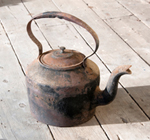
Cast iron kettle.
Always to be hanging over the
open fire and always to be kept full
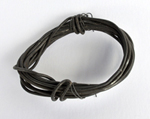
Ploughlink
We lost a circular link off the old
Stump-Jump
Plough and Lionel fashioned
this wire link from 8 gauge fence wire
to replace it (image below shows where it was fitted). He simply bent it around
and round with his bare hands,
such was his strength
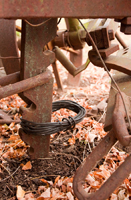
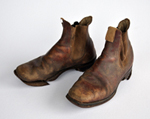
Lionel’s last work riding boots.
These figure in a framed drawing
by Lin Camac
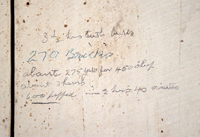
Notes written by Lionel.
The bottom three lines are,
275 gallons to dip 450 sheep
and it took 3 hours. 600
dipped in 2 hours 40 minutes.
It would seem to imply that
the earlier numbers had been
improved on, perhaps as he got
used to the new procedure.
These notes applied to the
more modern Shower Dip that
was installed, behind the cattle
yards, in the mid 1950’s to replace
the old Plunge Dip, which today
is beneath the floor of
Wethering Heights.
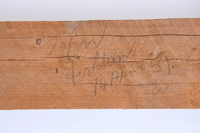
John Fishburn built the shearer's
bedrooms and left this ‘time capsule’ on
an off-cut of Cyprus 4” x 2”, stating his
name and dated 1951, in the ceiling.
John descended from the original
Thomas Fishburn, builder of Cook’s ship,
‘Endeavour’. He was son of Andrew
Fishburn, Coachbuilder and Undertaker,
Murrurundi. We had no idea
it was
there until renovating these
buildings into Cabins 3 and 4

Pump shower from Shearer’s
Bathroom. A bucket of water was
placed under the inlet pipe and the
handle pumped to shower. One
pump, one squirt from the
shower head
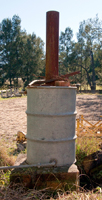
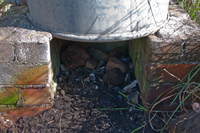
The Donkey - this was wood-fired
and provided the hot water for
the Shearer's Bathroom

Seed spreader for small
pasture seed
|
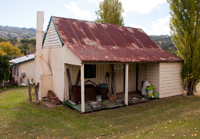
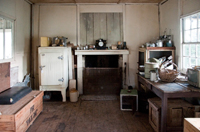
The kitchen
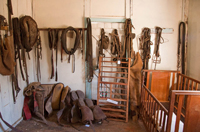
The bedroom
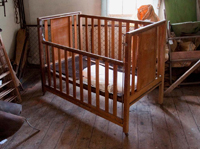
Peter's wooden baby cot
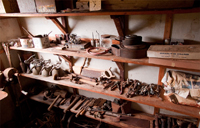
The Pantry - now home to a
large assortment of tools
preserved over the years.
Stock saddle
Peter’s. Barcoo Poley. Purchased
new MacKinnon’s Saddlery,
Tamworth, 1967. $95
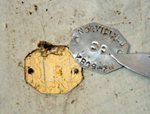
During war time Dog Tags were
crudely referred to as ‘Meat Tickets’, simply because when
they were mostly needed, was
to identify a dead soldier.
Dead soldier – dead meat.
After the war Lionel came back to Rock Dhu to live and work.
He nailed his tag on the wall
above the mantle shelf of
The Hut.
As years progressed the walls
of the building were lined with
sheets of Masonite and the tag
was covered over. Most of us
that came later, had no idea
it was there.
After Lionel retired he became
quite interested in our family
history. One day he told me to
prize that sheet of Masonite
off, remove the tag and
bring it to him.
It was added to his war
memorabilia.
The tags carried surname and
initials as well as service
identification number. In the
centre of the tag was
identification of religion, in
Lionel’s case, the letters CE,
which stood for ‘Church of
England’.
Interestingly, there was
another tag in his possession
also, bearing a different name.
A deceased mate? Unlikely we
will ever know for sure now.
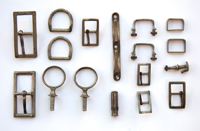
Harness fittings retrieved by
Lionel in his retirement and
polished for preservation

Lionel's last stock whip
before he retired

Scythe, for cutting grass
or crop
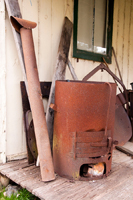
A Copper, for boiling and washing.
A fire is lit beneath

Forge
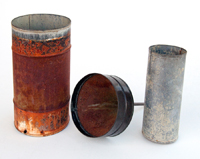
Rain gauge
This was in 3 water-holding
parts, plus a funnel running
down to a narrow tube. There
used to be a glass tube, inside
the steel inner tube, with the
measurement on it.
If the glass tube overflowed the
inner casing caught the surplus
and was in turn poured into the
glass for measurement until all
rain had been measured off.
Unfortunately glass is prone to
breakage in frost if it is sitting there full of water and once the
inner tube was gone
(unreplaceable) the gauge
was of no further use. |

First TV (Kriesler portable)
ever to come up this road.
Was AC/DC. As the electricity was not connected to this
area until 1970 we used to
run this TV off a car battery.
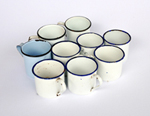
Shearers mugs
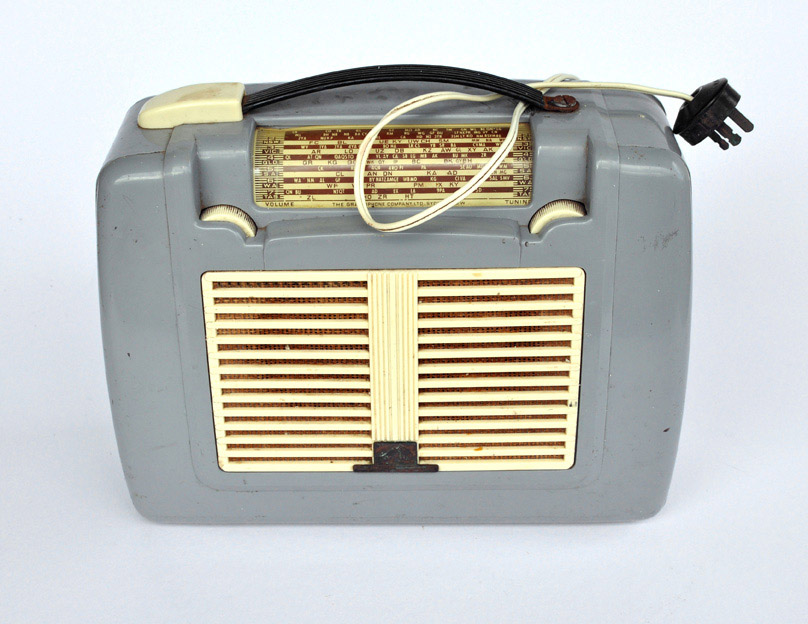
Portable radio (His Masters
Voice). Believed to be the
first radio of any kind on
the property. Was run with
a huge battery in the back.
Lionel loaned the radio to
a workman. The very first
night he managed to break
the switch on the side. This
was replaced with a 1951
threepence, pictured below.
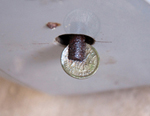
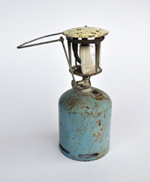
Primus propane lamp. This
filled in the brief gap between
kerosene lamps and electricity
arriving in 1970
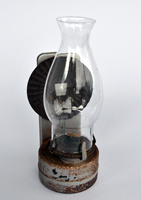
Kerosene lamp
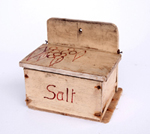
Enid's salt-cellar
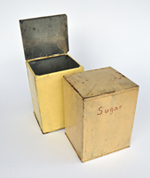
Enid's kitchen storage tins
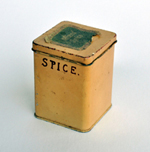
Enid's hand-painted spice tin
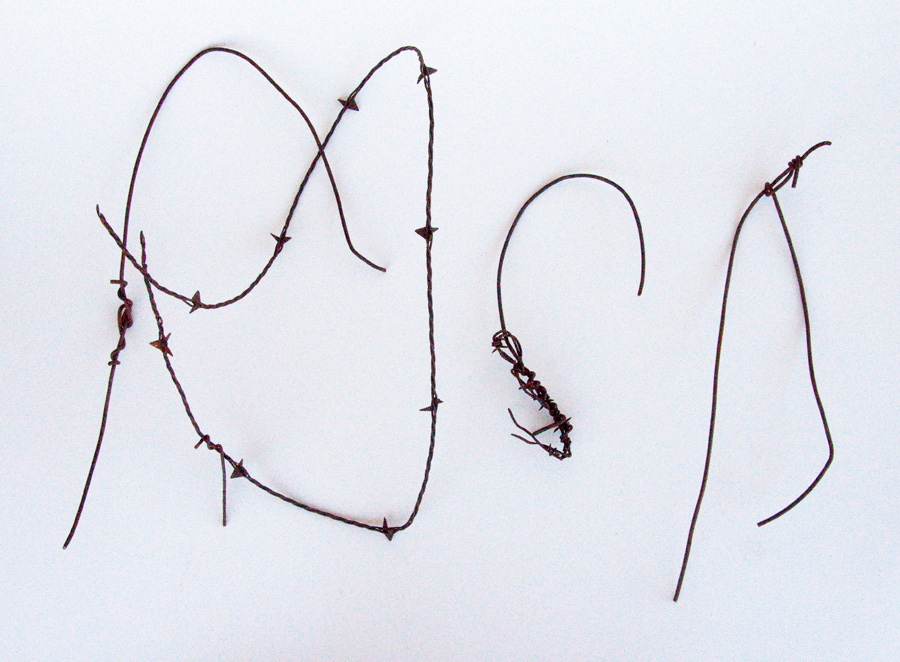
Various wire types and ties
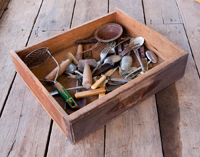
The kitchen table drawer, as it
was left after the Hut was last
used end of the 1960’s

Drill

Adze (above) and mortising
axe, used to cut out
recesses in posts
An adze was used to shave off
the curved surface of a felled
tree or log, for the purpose of
building, such as dwellings. An
adze had to be razor sharp and
hence needed care when using.
If a log was lying on the ground
while the adze was being used
stripping off the top surface, the
adze blow was travelling back
toward the user and between
his legs.
Hence, legs and feet were in
close proximity to the cutting
edge of the adze.
Small off-cuts (chips) from the
adze blows were occasionally
known to stick to the adze
cutting edge. If this happened
the next blow could carry that
off-cut with it back to the log
and the off-cut would often be
enough to cause the adze to
skip, or deflect, off the log
surface and in the operator’s
direction.
Such a skip was slippery fast
and the operator open to
serious injury if he was
not alert
|